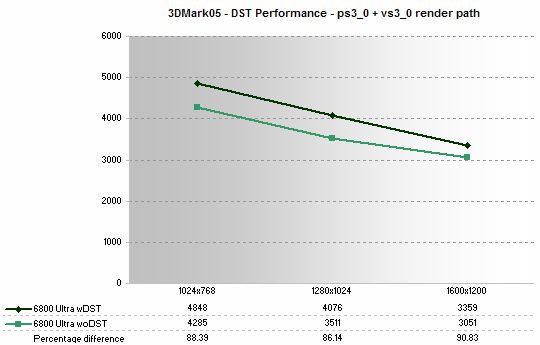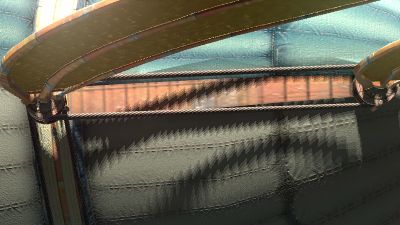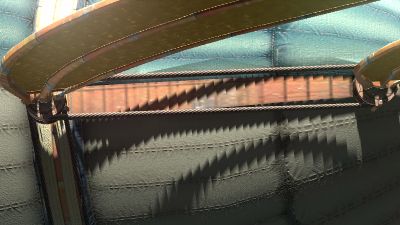DST Performance and Image Quality
I talked about DSTs on page two. Combined with hardware PCF, 3DMark05 uses NVIDIA's DST (depth stencil texture) capability in hardware that supports it to render the shadow maps before output rendering, as GeForce 6-series does. It's a specification that falls outside of DirectX, but Futuremark use it anyway. So it's prudent to see what impact it has on 3DMark05's performance and image quality. Can DSTs and the PCF filtering used for sampling the DST, give better image quality than the method used on all other hardware, or when you turn DSTs off? Let's look at performance first.Performance

Disabling DSTs and the PCF sampling gives between 10% and 16% performance loss, depending on resolution. So we can clearly see why NVIDIA asked Futuremark, as I assume they did, to use the alternate method of PSM rendering on compatible NVIDIA hardware.
If DSTs and the PCF filtering used in DST sampling can output comparable image quality, we can almost excuse its inclusion, given that Futuremark have gone on record in the past saying they'd not support vendor-specific extension to DirectX in their benchmarks.
Image Quality
Let's have a look at a cropped selection from frame 200 in Game Test 3, as we render it at 1600x1200 with 4X AA and 8X AF (AF isn't important, but AA is, as I'll explain) with DSTs on and off. At the top right of the image we can see shadow map aliasing that geometry anti-aliasing can't remove, as provided by our RGMS 4AA applied to the scene. Let's zoom in on that section with DSTs on and off.DSTs off first.
Now DSTs enabled, as is the default in 3DMark05, on supporting hardware.
Hopefully the difference is clear. The shadow umbra (the shadow's edge) is much softer with DSTs turned off, hinting that the sampling done in the fragment program when testing the depth value in the shadow map produces better results than the PCF sampling in compatible NVIDIA hardware. The image quality is worse with DSTs, the shadow edges are harsher than they should be, and the staircase stepping issue due to depth map resolution is exacerbated by the filtering method. It's not giving the results needed for good umbra rendering, in this reviewer's eyes.
Click here for a difference image of the two, so you can see just how much subtle detail is different between the two methods. DSTs are enabled in the left most image.
So while DSTs improve performance on compatible hardware, to the tune of anywhere between 10% and 16% in our tests, they most certainly do not give good output in 3DMark05's case, compared to the case where they're turned off. Again, they're ON by default on compatible hardware, increasing the chances of a non apples-to-apples comparison between hardware than can do DST acceleration, and hardware that can't.











